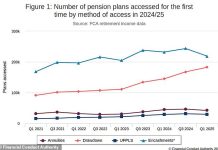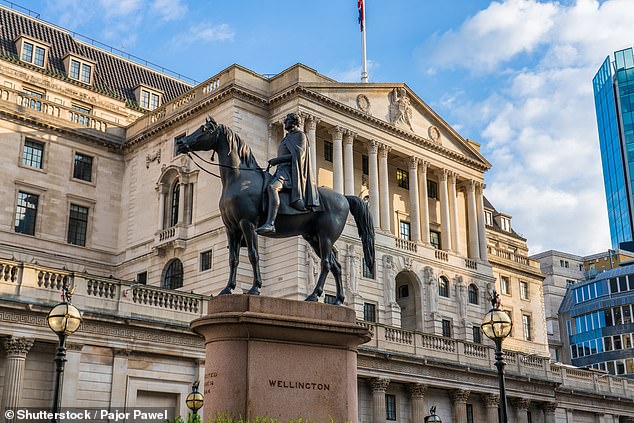The Bank of England has held interest rates at 4 per cent as it continues to tread carefully amid fears of resurgent inflation.
The decision came as little surprise, with a pause widely predicted by analysts.
At its meeting, the MPC voted by a majority of 7–2 to keep interest rates the same, with two members voting to cut by 0.25 percentage points.
The Bank’s previous decision in August was to cut rates from 4.25 to 4 per cent, taking base rate 1.25 percentage points below its 5.25 per cent peak just over a year ago.
The next decision will take place on 6 November, and will hinge on what happens to the rate of inflation, but also the health of the overall economy.
Today’s decision to hold rates is bad news for households hoping to see the cost of their mortgage reduce.
However, it will be received positively by savers, as interest on their accounts usually falls when the base rate goes down.
We explain what the Bank of England’s decision to hold rates at 4 per cent means for your mortgage and savings – and whether rates will be cut again soon.

No surprises: The Bank of England held rates at 4% a decision that was widely expected
What does this mean for mortgage borrowers?
Today’s decision to hold the base rate at 4 per cent will seem like bad news for mortgage borrowers.
However, most borrowers would have seen little immediate benefit even if rates had been cut.
Lenders usually base their pricing on the longer-term trajectory of interest rates, rather than reacting to individual base rate decisions.
Markets are now not fully pricing in another base rate cut until 2026.
On current market forecasts, interest rates will drop to 3.5 per cent in 2026 or 2027 and then stay there for some time before they will start to rise again.
Mortgage rates are already priced with these future cuts baked in. The cheapest two-year fix for someone remortgaging with 40 per cent equity in their home is currently 3.81 per cent, while the lowest five-year fix is 3.88 per cent.
Today’s decision means rates will stay around the same level according to Chris Sykes, a property finance specialist at mortgage broker MSP Financial Solutions.

Chris Sykes, a property finance specialist at MSP Financial Solutions
‘It’s no surprise it is a hold and no surprise is generally a good thing for the market as it provides consistency,’ said Sykes.
‘Mortgage lenders have been pricing in a hold so this means mortgage rates are unlikely to move much.
‘Tracker rates – which track the Bank of England base rate – will stay the same. variable rates are also unlikely to change much.’
Halifax and NatWest are offering the lowest fixed rates to those remortgaging with the largest amounts of equity in their homes.
Halifax is offering a 3.81 per cent two-year fix with a £999 fee, while NatWest is offering a 3.88 per cent five-year deal with a £1,495 fee.
Someone opting for the Halifax deal with a £200,000 mortgage and a 25 year repayment term could expect to pay £1,035 a month.
For home buyers with deposits of between 10 and 20 per cent, a number of the major lenders are offering rates just above the 4 per cent mark.
Someone buying with a 20 per cent deposit can get a rate of 4.02 per cent while those buying with a 10 per cent deposit can get 4.29 per cent.
On a £200,000 mortgage being repaid over a 25 year repayment term, a 4.29 per cent rate would equate to paying £1,088 a month.
> Mortgage calculator: Check the best rates based on your property value
What next for mortgage rates?
The future of interest rates hinges on the rate of inflation, but also on the health of the overall economy.
Yesterday, the ONS revealed that inflation remains a problem with fresh figures showing consumer prices inflation stuck at 3.8 per cent in August, way above the 2 per cent target.
Peter Stimson, director of mortgages at the lender MPowered, said: ‘Much as the Bank of England might wish to cut the base rate again to kick-start the stagnant economy, it cannot for fear of fanning the inflationary fire.
‘Consumer prices are still rising at nearly double the Bank’s 2 per cent target. This heat cauterised any chance of a September base rate cut, and a November base rate cut may be off the cards too.’
Ravesh Patel, director and senior mortgage consultant at broker Reside Mortgages is optimistic that if inflation comes down, the Bank will cut interest rates further than currently forecast.
‘In the short run, if inflation falls, then we may see lenders cut rates a little,’ says Patel.

Ravesh Patel, director and senior mortgage consultant at Reside Mortgages
‘The overall confidence and growth in the UK seems to be low – and rising interest rates may harm the economy.
‘For that reason, if inflation comes down, I would expect interest rates to continue to fall gradually. I expect base rate to fall to 3 per cent over the course of next year.’
However, Stimson is less optimistic about interest rates falling any further than 0.5 percentage points more – and for that reason he sees little scope for mortgage rates to fall from here on.
‘Swap rates, which track interest rate expectations and are used by mortgage lenders to determine the fixed interest rates they offer to borrowers, still suggest there will be two more base rate cuts in total, but the timing could now be pushed into next year,’ says Stimson.
‘Unfortunately for anyone planning to buy their first home or remortgage in the coming months, these two cuts have already been priced into the interest rates offered by lenders.
‘This means that even when they do come, the remaining base rate cuts are unlikely to make much of a dent on the mortgage interest rates offered to borrowers.
‘The awkward truth is that mortgage interest rates may have fallen as far as they can. Some lenders have inched up their rates in recent weeks, and today’s blowout inflation number will do nothing to reverse that trend.’
What does this mean for savers?
The base rate affects how much interest savers can earn on their money. In general, savings rates rise when the base rate is rising, and fall when it is falling.
Though the base rate has been held at 4 per cent, savings rates are on a steady downward trajectory. The best savings rates will likely continue to fall in the coming months.
Those who keep their cash in easy-access accounts are most at risk of rate cuts. The average easy access rate has fallen below 3 per cent, well below the CPI rate of 3.8 per cent.
The best easy-access savings accounts currently pay around 4.3 per cent, while some accounts with restrictions pay up to 5 per cent.
What next for savings rates?
Overall, savings rates will continue on a downward trend, according to rates scrutineer Moneyfacts Compare. The Moneyfacts average savings rate now stands at 3.46 per cent, down 0.34 per cent year-on-year.
James Blower, founder of savings website The Savings Guru said: ‘Current savings rates are significantly higher than they should be for a 4 per cent base rate which is expected to fall to 3.5 per cent.’
If the base rate falls to 3.5 per by spring 2026, as markets are currently predicting, it is forecast that easy-access rates will fall below 4 per cent for the first time since the summer of 2023, while fixed-rate bonds will fall to just above 4 per cent.
The best one-year fixed-rate bond currently pays 4.45 per cent. This is down from a high of 6.2 per cent in October 2023.
The best easy-access account pays 4.3 per cent which is down from a peak of 5.2 per cent in October 2023.
What should savers do now?
People should keep a close eye on their savings, whether they are stashed in an easy-access account, fixed-rate account or an Isa.
If your money is not working hard enough for you or earning interest at a rate of less than the rate of consumer price inflation, 3.8 per cent, you should consider moving it to an account paying a better rate.
Rachel Springall, finance expert at Moneyfacts said: ‘Those with cash stashed away for convenience with one of the biggest high street banks will find they pay an average of 1.52 per cent across easy access accounts.
‘Only a quarter of savings accounts on the market overall can beat 4 per cent, which shows how loyalty does not pay and why many savers could be losing money in real terms, due to inflation.
‘Now is the time for savers to ditch and switch elsewhere, such as to mutuals or challenger banks that are paying attractive rates.’
Savers who do not want to see their cash eroded by inflation should lock away heir savings in a fixed-rate bond or Isa with many paying a guaranteed return of 4 per cent or more.
James Blower says: ‘This is still a great time for savers to lock away their savings in comparison with where rates are likely to be later this year and in to 2026.’
Best savings rates and how to find them
The best easy-access savings accounts with no restrictions pay 4.3 per cent.
Spring is offering a market-leading easy-access deal paying 4.3 per cent. Someone putting £10,000 in this account could expect to earn £430 in interest after a year, if the rate remained the same.
Those with cash they won’t immediately need over the next year or two should consider fixed-rate savings.
The best one-year deal is offered by Chetwood Bank paying 4.45 per cent. A saver putting £10,000 in this account will earn a guaranteed £445 interest over one year. It comes with full protection under the Financial Services Compensation Scheme up to £85,000 per person.
Union Bank of India is offering 4.47 per cent, while Stream Bank is paying 4.41 per cent. All offer FSCS protection.
The best two-year bond pays 4.44 per cent and comes from Birmingham Bank. This provider also offers the best three and five-year bonds which both pay 4.46 and 4.53 per cent respectively.
Savers should strongly consider using a cash Isa to protect the interest they earn from being taxed.
The best cash Isa currently comes from Trading 212* which pays 4.38 per cent
SAVE MONEY, MAKE MONEY

Sipp cashback

Sipp cashback
£200 when you deposit or transfer £15,000
4.38% cash Isa
4.38% cash Isa
Trading 212: 0.53% fixed 12-month bonus

£20 off motoring

£20 off motoring
This is Money Motoring Club voucher

Up to £100 free share

Up to £100 free share
Get a free share worth £10 to £100

No fees on 30 funds

No fees on 30 funds
Potentially zero-fee investing in an Isa or Sipp
Affiliate links: If you take out a product This is Money may earn a commission. These deals are chosen by our editorial team, as we think they are worth highlighting. This does not affect our editorial independence. Terms and conditions apply on all offers.
#Bank #England #interest #rate #hold #means #mortgage #savings
















